Confronting toxic masculinity
When taken to an extreme, its impact permeates numerous facets of daily life: sexuality, appearance, athletics, group dynamics. Through their own experiences, students and faculty consider toxic masculinity's core ideas, how it manifests at ASL and whom its consequences affect.
March 5, 2021
In Music Teacher David Papenhagen’s old school in Michigan, having a reputation as a band geek was better than being gay. At least that is the message his assistant principal conveyed while trying to motivate one of his students to work harder in his band class.
“That assistant principal looked that kid straight in the eye and said, ‘Look, what, what happens if, you know, people start spreading a rumor, like a really bad rumor that you are gay or something. That would be awful,’” Papenhagen said.
At the time, Papenhagen was not out as gay. He had to sit quietly in the room while his employer denigrated his sexuality. His first thought was, “I need to look for another job.” He said he was tired of enduring what he saw as “his America,” a place which treated him as if his identity was incompatible with its values.
After moving from the U.S., where toxic masculinity created an inhospitable environment, to London, Papenhagen said he found ASL to be more tolerant. However, he said the school is not immune to the problems toxic masculinity creates.
Defining toxic masculinity
According to Oxford English Dictionary, toxic masculinity is defined as “a set of attitudes and ways of behaving stereotypically associated with or expected of men, regarded as having a negative impact on men and on society as a whole.”
Dylan Linton (’23) said it entails a “preconceived notion that men have to be a certain way and they have to act a certain way.”
Connor Eaton (’21) said he is on the fence about the premise. On the one hand, he points to certain historical benefits of masculinity – it was traditional masculinity that liberated Bergen-Belsen and stormed the beaches of Normandy.
On the other hand, he said institutions of masculinity can be “correlated with innumerable social issues that affect men just as much as anyone else.”
Dismantling the man box
The man box implies a rigid set of expectations, perceptions and behaviors of what is “manly,” according to the University of Richmond.
Assistant Principal Natalie Jaworski said when a man does not conform to the confines of the box, others have a tendency to make fun of them.
“Anytime you’re outside the box, you’re in a position to be mocked or to be thought of as like, not enough of a man,” she said.
From the inside of the box, Gabi Dawson (’24) said people who align themselves with these societal norms often pull people back in.
“They don’t like people getting out of the box,” she said.
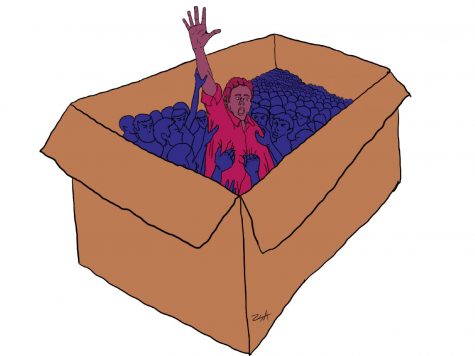
Eaton said one detriment of the box is that men are discouraged from engaging in “extraneous emotion” as they are the ones others traditionally depend upon. This, he said, has partially led to issues that disproportionately affect men, such as higher suicide and homelessness rates.
“I don’t necessarily see toxic masculinity as having necessarily caused all these things,” he said. “But I think there is a correlation.”
In addition, Social Studies Teacher Terry Gladis said the standards laid out in the man box have created social hierarchies which, for example, regard athletes as more manly, thus allocating them more social capital. He said, though, ASL has gone through an evolution on this practice.
[Click here to listen] “Holy moly, if you want to go back 15 years, without a doubt, there was, there was a huge status regarding athletes,” he said.
However, Papenhagen said male athletes remain socially respected more than students who participate in other activities. He said the starting five on the basketball team are held up above the students who are “kicking butt” on the robotics team.
“There are systems and traditions in place that almost emphasize the man box,” he said.
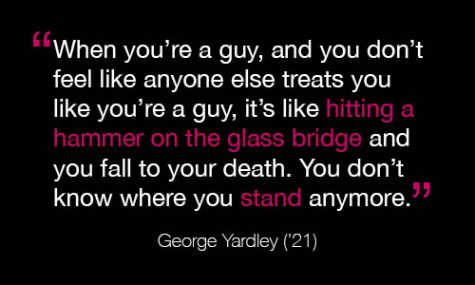
Furthermore, Linton said the sports aspect of the man box is still prevalent, which dictates that “guys have to play sports and be good at sports, follow sports to be masculine.”
George Yardley (’21) said everyone is standing on a metaphorical glass bridge; a metaphor which is particularly germane when applied to the toxic environment among men.
“Sometimes when you’re a guy, and you don’t feel like anyone else thinks you’re a guy and acts like you, treats you like you’re a guy, it’s like hitting a hammer on the glass bridge and you fall to your death,” he said. “Because you don’t know where you stand anymore. You don’t know where you fit in. You don’t know who you are. You don’t know what you want to be.”
Ultimately, Gladis said often the man box not only forces societal norms, but obscures men’s views of their own masculinity as well. He paused, leaned forward and said, “Am I living in the box?”
Toxic masculinity at ASL
Jaworski said although ASL is not exempt from toxic masculinity, it fares far better than her previous school in Minneapolis, Minnesota, because students at ASL have more open minds. At this school, she said, students can be on the basketball team and in the musical.
“A lot of students really understand how lucky they are to have the education they have in ASL,” she said. “They want to take advantage of it. It’s not just about coming here to play sports. You have some people who kind of cross those more than other schools.”
Dawson said conversations about how toxic masculinity manifests at ASL are difficult to engage in because many people have trouble confronting the problem.
“We can’t have an open conversation about what’s actually happening when people are in denial,” she said.
Furthermore, Yardley said this difficulty is exacerbated by the school culture’s inclination to hyper-focus on different worries, such as future academic plans, rather than those related to gender.
[Click here to listen] “ASL is always like, ‘Ooh college, what do you want to study?’” he said. “How the f*** am I supposed to know? I don’t even know if people think I’m a boy.”
Jaworski said another challenge from an administrative point of view is how hard it is for members of the community to tell the administration about incidents that are a product of toxic masculinity. Gladis dubbed these unspoken incidents “blind spots.”
“There can be lots of things happening that I’m not aware of unless someone comes forward, which is a really, really hard thing to do,” Jaworski said.
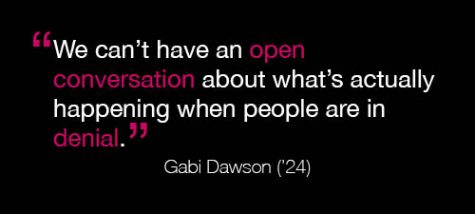
Difficulty in coming forward is one of the reasons Jaworski said it’s really important students have access to administrators who are different genders.
Yardley said the administration is often less cognizant of problems stemming from toxic masculinity, and thus relies on the student body to shed light on these issues.
“Maybe the ASL administration isn’t always pulling their weight,” he said. “But I do think the student body does a good job of putting pressure on them.”
In response, Jaworski said combating toxic masculinity requires the collaborative efforts of a student-faculty-administration coalition.
Furthermore, Gladis said an increase in this type of collaboration has facilitated more accountability within the community.
“Do I think the administration is taking steps to get better?” he said. “Yes. But we can all do better.”
Jaworski said the end goal is to help men feel as though they can speak up when they observe instances of toxic masculinity.
“How do we bring, you know, boys into a conversation to be able to actually stop this kind of toxic masculinity?” she said. “Because a lot of times the toxic masculinity is happening in spaces where women aren’t.”
Ultimately, Jaworski said if we’re not empowering men to say to their friends, “‘That’s really not okay,’” then women are cutting out “our most important allies and upstanders.”
Appearance
Yardley cuffs his pants, a habit he picked up living in Italy, where he said people are singled out if they don’t conform to the fashion-based culture.
[Click here to listen] “They have a phrase, ‘la bella figura,’ which means you don’t go outside, basically, unless you look good,” he said. “And if you do, you’re labeled … an American tourist. And I really didn’t want to be an American tourist.”
The culture at ASL treated Yardley differently than in Italy. When he moved to the school in Grade 9, he said his fashion choices meant he was now the one being singled out; students labeled him as gay. He paused after saying this – his expression one of befuddlement.
Nonetheless, Yardley said one hypothesis might be the damaging equation of metrosexuality to femininity, which in turn is aligned with homosexuality. He said men that care about the way they look send the “wrong message that ‘I’m beautiful, come here and protect me,’ which falls much more into the stereotypes of what people think gay men are like than what people think straight men are like.”
Jaworski said she notices a discontinuity between the relationships that younger generations and older generations have with gender. She said younger generations are accepting of gender fluidity, whereas older ones maintain more rigid definitions.
Furthermore, Jaworski said older people tend to use clothing as a sure-fire signifier of gender, and thus they would, due to their traditional perceptions of gender, force stereotypical clothing on people.
[Click here to listen] “‘I must know: are you a boy or a girl?’” she said, as an example of how older people think. “‘And if you decide that you’re one, then you must dress that way.’”
In the same vein, makeup can differentiate gender. Papenhagen said although ASL is one of the safest places for a boy to wear makeup, a male student might hesitate when considering wearing makeup to school.
“Are there things at ASL that would kind of make that student or give that student pause?” he said. “Absolutely … We’re still a very American school in some ways.”
Similarly, Linton said while the American layer to the school’s identity still shows its colors, it would be more accepting of a boy in makeup than schools in the U.S.
According to Papenhagen, “the man box is much bigger in America.”
Homophobia
Library Administrative Assistant Steve Reed, married to Papenhagen, said he clearly remembers instances of homophobia directed toward him at ASL. Once, he said when trying to calm down a group of Grade 9 students in the library, one boy reached his arm around his shoulder and stuck his tongue out as if to kiss his cheek.
In retrospect, Reed said about the boy, “I don’t think you would do that if I were a straight man.”
Dawson and Linton said they notice the word “gay” frequently being used as a synonym for “bad,” classifying this likening as flippant homophobia.
Dawson said people have a tendency to say “‘that’s so gay’ for issues where they don’t feel comfortable with someone, I guess, being their self.”
Similarly, Linton said this phenomenon of casual homophobia is damaging for the LGBTQ+ community at large.
“Referring to something that’s bad as ‘gay’ is putting the whole community down,” he said.
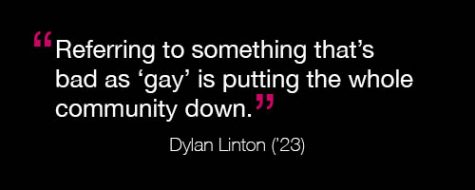
In addition, Linton said there’s a power structure at play when it comes to men calling people gay. He said these men want to seem more masculine by distinguishing themselves as separate from the LGBTQ+ community.
Yardley said this othering happens as a means of masking one’s own insecurities.
“The clothes you wear, sometimes people call you ‘gay’ for it,” he said. “That’s just the scapegoat of, ‘I need to differentiate you and me right now because I’m— I’ve decided that you are weak, and I’m not weak.’”
Yardley was asked to consider how his experience with his cuffed pants would have been different if he were closeted. He paused to think, then said, “Tough, that is for sure,” especially in what he sees as an “objectively homophobic environment” among boys at ASL.
[Click here to listen] “A gay man is sexually attracted to another man,” he said. “That’s intrinsic about them. That’s not changing.
“It doesn’t change with the weather or the seasons or anything,” he said. “So when everyone around you is … making that seem as though that’s a negative, but it is intrinsically you, that’s hard to grapple with.”
Linton said ASL can be an unwelcoming environment for people questioning their sexuality. Specifically, someone describing something as gay could make someone questioning their sexuality feel uncomfortable. He said they could even feel like their identity is socially unacceptable.
Pack mentality
Jaworski said she notices a trend of pack mentality at ASL and with men in general. Pack mentality, also known as herd mentality, is the “tendency for people’s behavior or beliefs to conform to those of the group to which they belong,” per Oxford English Dictionary.
Similarly, Gladis said toxic masculinity festers due to pack dynamics. In a pack, he said some men are leaders, and some are much more comfortable following as sheep. Followers “need to impress the alpha, and the way to impress that alpha is to crack a joke.”
Yardley echoed Gladis’ sentiment and said that in groups of boys, “everyone is there to establish himself as the alpha male,” which has a negative effect on the actions of the group.
Gladis said he can pick out one situation where toxic masculinity surfaces in packs at ASL: the left side of the bleachers during home basketball games. He smiled and added, usually against ACS Cobham.
Impact on women
Beyond the immediate consequences pack dynamics can have on men, Yardley said this mentality can have negative effects on women.
“When you take that psychological aspect of man and put it and pair it with this desire to prove yourself and be, be cool and be manly in front of a group of guys, what you get is some pretty demeaning and sexist conversation,” he said.
Even worse, Yardley said pack mentality can create an environment which encourages acting without consent.
Jaworksi referenced Primark shirts which, she said, reinforce these archaic gender roles. She said a blue shirt marketed to boys read on the front, “Line up ladies, there’s only one of me,” while the girl’s shirt read, “My daddy will never let me date.” Eyes wide, she emphasized the shirts were for 2-year-olds.
Jaworski said these shirts are evidence of how societal gender norms manifest, specifically in regard to a feeling of entitlement over women.
[Click here to listen] “For males, it’s already at 2 years old expecting sexual conquests, and like the number of partners that you would have would make you, like, stronger,” she said. “And then for girls, that not only should they never have sexual partners, but that their father is the person who is in control of them.”
Yardley said men expect sex because of inherent animalistic traits, something he calls “caveman psychology,” which includes traditional, outdated gender roles.
[Click here to listen] “We often forget that we are animals just as much as any other animal is,” he said. “We have very survival-based chemical needs. And so for guys, sex is a necessity. Like, the same way we get hungry, we have sexual desire. There’s no difference between the two of them.”
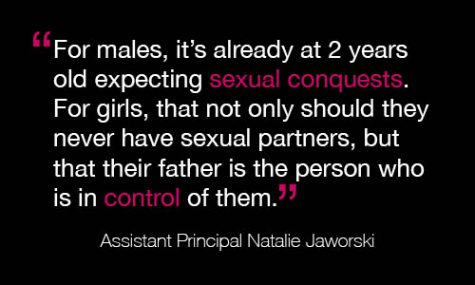
When it comes to breeding grounds for toxic masculinity, Yardley said the school’s Fitness Center is a prime example of how a pursuit of dominance can infect the atmosphere.
“Something just about the environment of the gym made me feel like I needed to exert my own presence and dominance,” he said. “Literally like tigers or lions fighting over the territory.”
One day a week at the Fitness Center was set aside for only women to work out, which Yardley said he believes was because toxic masculinity lent itself to an environment which can deter those who don’t conscribe to stereotypical masculine ideals.
Linton said, historically, there has been a superiority complex associated with men and women.
He said this complex plays into sexism because men feel like they have to act better than and downplay the achievements of women in order to make themselves feel more secure.
Following this complex, Jaworski said women in positions of power must prove their worth as toxic masculinity facilitates the limiting of women to less powerful roles.

She said one scenario that is ingrained in her memory is when she was social studies department head, and the team went on an after-hours tour of a museum. When they arrived, she approached the curator to introduce herself. The curator, a man, asked to speak to the head of the department. She responded “‘that’s me.’” In surprise, he said, “‘Oh, you’re their boss?’”
Jaworski said this experience was uncomfortable and embarrassing because the curator had immediately written her off as someone incapable of holding such a position. Although she was younger at the time, Jaworksi said she imagines if she had been a man of a similar age, the curator wouldn’t have responded in the same shocked fashion.
However, Jaworski said her colleagues seemed to recognize the sexist nature of the situation and acknowledged how toxic it was.
Confronting complicity
Over the past 10 years, Jaworski said she has realized how her upbringing set her on a path in line with society’s square gender ideals; she was raised in pink shirts and not blue ones.
Jaworski said “we still run up against our own biases, our own experience, our own toxic masculinity or femininity,” which makes people unsure about what to do with someone who isn’t “fitting our mold.”
When the idea of toxic masculinity is posited to men, Eaton said they can become defensive due to a preconception that it labels all masculinity as toxic. He said they might even feel like their identity as a male is less valued because of the idea of toxic masculinity.
Similarly, Dawson said some people are aware of how much toxicity they emanate, while others are in denial because they are uncomfortable self-criticizing. Gladis said this tendency is sometimes “systemic” at ASL, as toxicity is often excused, hence confrontation is not forced.
However, after years of reflection, Gladis said he can see how he has contributed to a toxically masculine environment.
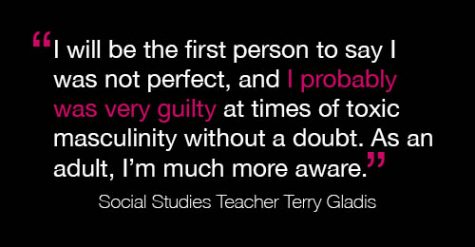
“I will be the first person to say I was not perfect, and I probably was very guilty at times of toxic masculinity without a doubt,” he said. “As an adult, I’m much more aware.”
Gladis said running up against the effects of his own toxic masculinity catalyzed a personal reckoning.
“I learned I was guilty,” he said, “And I feel terrible.”
Now that he has two daughters, Gladis said there’s more riding on his awareness; any toxic behavior he exhibited when he was younger cannot be represented in front of his children.
[Click here to listen] “I’m the only male in the household, and it’s important that I model what a man should be,” he said.
Instances of reflection like Gladis’ are few and far between according to Yardley. To stand up to toxic masculinity, he said men have to confront a series of obstacles first.
“The more pressure there is to be this type of strong, unemotional, steadfast man, the less and less they talk about these things,” he said. “So they’re totally internally unfamiliar with some of their own emotional struggles.”
Yardley said plenty of men wouldn’t feel comfortable sharing their experiences with toxic masculinity. He said “it’s not easy” to be so vulnerable, “it’s not easy at all.”
“There are probably hundreds of other stories,” he said.




Mr. Reid • Mar 8, 2021 at 9:57 am
The internal path to freedom from toxic masculinity (a necessary correlate to cultural and policy changes) is internal. There is no path to those hallowed shores without embracing the blessings of vulnerability.
Wonderful to see the high school carrying on this important journey reminiscent of our forays in middle school health.